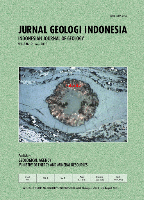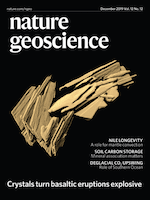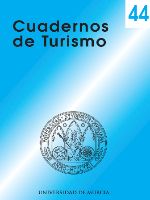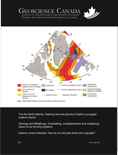
Geoheritage
metrics 2024
Connecting Geoscience and Cultural Significance for a Sustainable Future
Introduction
Geoheritage is a premier journal published by Springer Heidelberg, focusing on the interdisciplinary study of geoscience and its cultural significance. Established in 2009, the journal has quickly secured a prominent position in its field, reflecting its commitment to genuine academic inquiry and the dissemination of knowledge. With an impressive impact factor derived from its robust Scopus rankings – including a Q2 classification in Earth and Planetary Sciences, Geography, Planning and Development, and Nature and Landscape Conservation categories – Geoheritage provides a vital platform for researchers and professionals eager to explore and highlight Earth's geodiversity and heritage. The journal's scope encompasses numerous themes, including conservation practices, the role of geology in environmental planning, and the significance of landforms in culture. Although the journal currently does not operate under an open access model, it remains a crucial resource for those engaged in academia, environmental science, and cultural heritage studies, fostering invaluable discussions and insights that contribute to our understanding of Earth's landscapes. Its publication address is located in the heart of Germany, at Tiergartenstrasse 17, D-69121 Heidelberg, ensuring its connection to a rich geographical context.
Metrics 2024
 0.59
0.59 2.30
2.30 2.90
2.90 44
44Metrics History
Rank 2024
Scopus
IF (Web Of Science)
JCI (Web Of Science)
Quartile History
Similar Journals

Ecological Questions
Exploring the Frontiers of Ecological Knowledge.Ecological Questions is a distinguished academic journal published by WYDAWNICTWO UNIWERSYTETU MIKOLAJA KOPERNIKA, dedicated to the diverse and evolving field of ecology. With ISSN 1644-7298 and E-ISSN 2083-5469, this journal promotes the dissemination of high-quality research and innovative methodologies in ecological modeling, evolutionary studies, and geographical planning. Its ongoing publication, active from 2002 to 2024, reflects its commitment to fostering interdisciplinary dialogue among ecologists and related scientists. Currently categorized in Q3 across several fields, including Ecology and Ecological Modeling, Ecological Questions serves as a vital resource for both emerging and established researchers, providing insight into current environmental challenges and theoretical advancements. Access to this journal enhances the knowledge base within academia, equipping professionals and students alike with essential information to advance their work and studies in ecology.

Economic and Environmental Geology
Exploring the Nexus of Resources and SustainabilityEconomic and Environmental Geology is a peer-reviewed journal published by the Korea Society for Economic & Environmental Geology, focusing on critical intersections within the fields of economic geology and environmental science. With an ISSN of 1225-7281 and an E-ISSN of 2288-7962, this journal serves as a vital platform for researchers, professionals, and students engaged in the comprehensive study of geological resources and their impacts on the environment. As of 2023, the journal is categorized in the Q4 quartile for both Economic Geology and Environmental Science, indicating its emergent impact in these domains. Despite being in the early stages of its convergence from 2017 to 2024, the journal holds importance for advancing knowledge and fostering discussions about sustainable geological practices in South Korea and beyond. The journal does not currently offer open-access options, but it continues to provide essential insights into the challenges and innovations within economic and environmental geology.

GEOMORPHOLOGY
Advancing Insights into Landform Processes.GEOMORPHOLOGY, published by Elsevier, is a leading journal that focuses on the study of landforms, along with the processes that shape them. Established in 1984, the journal has evolved to become an essential resource for researchers in the field of Earth-Surface Processes, currently holding a prestigious Q1 quartile ranking and occupying the 17th position out of 179 journals in Scopus, placing it within the top 10% of publications in this domain. This impact underscores its significance in advancing understanding within geosciences, providing a platform for both foundational and innovative research. GEOMORPHOLOGY publishes a diverse array of articles, from empirical studies to theoretical advancements, ensuring accessibility for a broad audience of students, professionals, and academics alike. With its commitment to high-quality research, this journal serves as a critical reference point for ongoing developments and discoveries in geomorphology.

Indonesian Journal of Geoscience
Empowering Geoscientists with Open Access Insights.Indonesian Journal of Geoscience, published by the GEOLOGICAL AGENCY, is a vital platform for sharing cutting-edge research in the field of Earth and Planetary Sciences. With an ISSN of 2355-9314 and E-ISSN of 2355-9306, this open-access journal has been making significant contributions to the geoscientific community since its establishment in 2013. Operating out of Bandung, Indonesia, the journal is dedicated to disseminating high-quality research across diverse areas, making it an essential resource for researchers, professionals, and students alike. Recognized in the 2023 Q2 category in Earth and Planetary Sciences, it currently ranks #134/195 among general Earth and Planetary Sciences journals in Scopus, reflecting its growing prominence and academic rigor. The journal seeks to foster scientific discussions by publishing original research, reviews, and case studies that address contemporary challenges and advancements in geoscience, thus contributing to a deeper understanding of our planet. With its commitment to open access, the Indonesian Journal of Geoscience ensures that vital research is accessible to a global audience, encouraging collaboration and innovation in the field.

Andean Geology
Advancing Earth Sciences Across the AndesAndean Geology is a prominent open-access journal, published by the SERVICIO NACIONAL GEOLOGIA MINERVA in Chile, dedicated to advancing the fields of geology, geochemistry, petrology, paleontology, and stratigraphy. Since its inception in 2009, the journal has provided a vital platform for the dissemination of research pertaining to the Andean region and beyond, featuring high-quality articles that contribute to our understanding of earth sciences. With an impressive ranking in the Q2 and Q3 quartiles across multiple categories, it reflects a growing impact in the geological community, evidenced by its status within Scopus rankings. Andean Geology not only supports the academic pursuit of knowledge with its open-access policy but also aims to foster collaboration among researchers and professionals worldwide, ensuring wide accessibility of groundbreaking research and promoting academic engagement. By covering a diverse array of topics relevant to the dynamic field of geology, this journal serves as an essential resource for students, professionals, and scholars dedicated to earth and planetary sciences.

Journal of Heritage Tourism
Uncovering the Stories Behind Every DestinationJournal of Heritage Tourism, published by Routledge Journals, part of Taylor & Francis Ltd, is a leading peer-reviewed journal dedicated to the interdisciplinary study of heritage tourism. As a vital resource for researchers, professionals, and students in the fields of History and Tourism, Leisure and Hospitality Management, this journal has consistently achieved high rankings, securing a Q1 quartile in History and Q2 in Tourism for 2023. With an impressive Scopus rank of #3 out of 1760 in Arts and Humanities - History and #42 out of 146 in Business - Tourism, it underscores the journal’s importance and relevance in contemporary scholarship. Spanning contributions from 2006 to 2024, the journal provides a platform for innovative research, critical discussions, and comprehensive analyses, fostering a greater understanding of the complex relationships between heritage and tourism. Although it does not currently offer open access, insights published within this journal remain accessible for institutional libraries and academic communities worldwide, ensuring that the ongoing discourse around heritage tourism flourishes.

Nature Geoscience
Leading the Charge in Geoscientific Discovery.Nature Geoscience, a premier journal published by NATURE PORTFOLIO, provides a platform for the dissemination of high-quality research in Earth and Planetary Sciences. With an impressive impact factor reflecting its significance — ranking in the 99th percentile and positioned at #1 out of 195 in Scopus Ranks within its category, this journal is a leading authority in its field. Since its inception in 2008, it has fostered interdisciplinary collaboration, addressing critical challenges such as climate change, natural disasters, and resource management. Although it does not offer Open Access, the journal is accessible through various research libraries, ensuring that vital findings reach a broad audience. The journal's esteemed reputation in the Q1 quartile of Earth and Planetary Sciences makes it an essential resource for researchers, professionals, and students aiming to advance their understanding of geoscientific phenomena.

Cuadernos de Turismo
Advancing knowledge at the intersection of tourism and conservation.Cuadernos de Turismo is a peer-reviewed academic journal published by Universidad de Murcia, focusing on the interdisciplinary fields of geography, tourism, and environmental conservation. Since its inception in 1998, this Open Access journal has provided a platform for researchers, professionals, and students to share innovative research and insights in the domains of tourism, leisure, and sustainable landscape management. Leveraging its Q4 ranking across multiple categories in 2023, Cuadernos de Turismo stands as a crucial resource for exploring contemporary challenges and developments in tourism and its implications for regional planning and environmental conservation. With its commitment to accessibility and scholarly communication, the journal fosters collaboration and dialogue among scholars and practitioners globally, making significant contributions to the understanding and development of sustainable tourism practices.

GEOSCIENCE CANADA
Unveiling the Mysteries of Earth and BeyondGEOSCIENCE CANADA is a premier academic journal published by the Geological Association of Canada, dedicated to advancing knowledge and research in the field of Earth and Planetary Sciences. With an ISSN of 0315-0941 and an E-ISSN of 1911-4850, this journal has been a key platform for scholarly discourse since its inception in 1979, continuing its valuable contributions through to 2024. Positioned in the Q2 quartile for Earth and Planetary Sciences (miscellaneous) as per the 2023 rankings, GEOSCIENCE CANADA is recognized for its rigorous peer-review process and impactful publications, making it a vital resource for researchers, professionals, and students alike. The journal covers a broad array of topics within geoscience, promoting innovative research and discussions pertinent to geologists and Earth scientists across Canada and internationally. While it does not currently provide open access options, the journal continues to support a diverse readership eager to engage with cutting-edge studies that shape the understanding of Earth's processes.

AIMS Geosciences
Innovating Research for a Sustainable PlanetAIMS Geosciences, published by the American Institute of Mathematical Sciences (AIMS), is an esteemed open-access journal that has been serving the geosciences community since its inception in 2015. With an ISSN of 2471-2132, the journal disseminates high-quality research pertaining to various disciplines within geosciences, including geology, meteorology, oceanography, and environmental science. By promoting freely accessible research findings, AIMS Geosciences aims to foster collaboration and innovation among researchers, professionals, and students alike. The journal upholds rigorous peer-review standards, ensuring that only the most impactful research is shared with the global academic community. Situated at the forefront of geoscientific inquiry, this journal not only enhances the visibility of cutting-edge research but also contributes significantly to the understanding of Earth's processes, making it an essential resource for anyone engaged in this vital field.